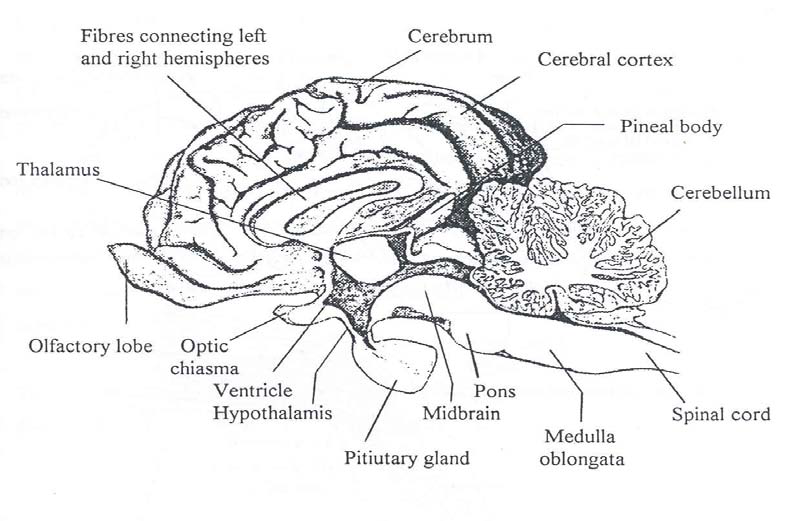The nervous system as a whole is well protected by bones. When a nerve has injured the process of recovery, also called regeneration, can take a long time e.g. the facial nerve in the horse. Brain cells, however, cannot recover after injury. The nervous system consists of the following:
The central nervous system:
- Brain
- Cerebrum
- Cerebellum
- Medulla oblongata
Spinal cord:
Peripheral nerves:
- Voluntary nerves
- Motor nerve fibres
- Sensory nerve fibres
- Autonomic nerves are also called involuntary nerves.
- Sympathetic nerve fibres
- Parasympathetic nerve fibres

The Brain
The brain serves to coordinate all the functions of the body. In humans and higher primates, it makes thinking and reasoning possible. It is, however, difficult to prove that other animals can or cannot think. There are also various centres in the brain which control certain functions involuntarily e.g., respiration, blood pressure, heartbeat etc.
The Spinal Cord
The spinal cord transmits the stimuli from the peripheral nerves to the brain and also from the brain back to the nerves branching from it. The voluntary nerves consist of a number of branching fibres running from the brain through the spinal cord to mainly the muscles and skin. Each branch consists of motor fibres carrying stimuli from the brain to an organ and sensory fibres, which carry stimuli from the organ to the brain i.e., the nerve fibres from the skin to the spinal cord, are sensory fibres and those from the spinal cord to the muscle are motor fibres. The sensory fibres relay stimuli from e.g., the skin to the brain where the animal takes note of them. The brain sends stimuli via the motor fibres to the muscles, which then react. Furthermore, the spinal cord is also the reflex centre. Sometimes a speedy reaction to a stimulus e.g., to prevent tissue damage, is required. In this instance to get a more rapid reaction the stimulus takes a shortcut via the sensory nerves through the spinal cord to the motor nerves Without involving the brain. Only after the reaction has taken place does the individual become aware of it. This shortcut is called a reflex arc. When, for instance, a hot object is touched, the hand is pulled back before one becomes aware of the heat.
The Autonomic Nervous System
The function of the autonomic nervous system is to control the organs, which fall outside the control of the voluntary will. This includes control of the heart rate, intestinal peristalsis, etc. In some cases, the organs fall under the control of the autonomic nervous system as well as the endocrine system resulting in close cooperation between the two systems. The physical appearance of these nerves is identical to that of the voluntary system and the only way we are able to distinguish between the two is in the functions that they perform and the organs that they supply. Because the autonomic nervous system causes two different reactions in each organ it supplies, it is divided into two parts namely the sympathetic part, which has approximately the same action as the hormone adrenalin, and the parasympathetic part, which has basically the same action as the hormone acetylcholine.
The receptors of the nerves can be divided into two groups according to the sensations they induce:
Those, which provide general sensations: These sensations, with the exception of pain, seldom penetrate the conscious mind.
Those, which provide specific sensations: These differ from each other regarding their anatomical structure, the type of stimuli to which they react and the nature of the sensation which they provide. In the next table, the most common classification of receptors is given.
|
Sense Organ |
Nature of Sensation |
|
Skin |
Touch (pain, heat, cold) |
|
Eye |
Vision (light, colour, distance) |
|
Ear |
Hearing (pitch, intensity, direction) |
|
Tongue |
Taste (sour, sweet, salt, bitter) |
|
Nose |
Smell |
Classification of receptors